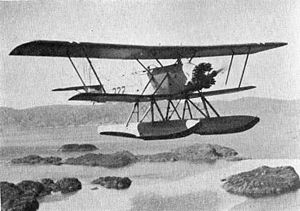Marinens Flyvebaatfabrikk M.F.11
| Marinens Flyvebaatfabrikk M.F.11 | |
|---|---|
 |
|
| M.F.11 F.322 in RNNAS service | |
| Role | Maritime reconnaissance |
| Manufacturer | Marinens Flyvebaatfabrikk |
| Designer | Captain Johan E. Høver |
| First flight | 29 September 1931 |
| Introduction | 1932 |
| Primary users |
Royal Norwegian Navy Air Service Luftwaffe Finnish Air Force |
| Produced | 11 October 1930 - 1 January 1939 |
| Number built | 29 |
| Developed from | Marinens Flyvebaatfabrikk M.F.10 |
The Marinens Flyvebaatfabrikk M.F.11 (sometimes known as the Høver M.F.11 after its designer) was a three-seat, single-engined biplane used by the Royal Norwegian Navy Air Service for maritime reconnaissance in the decade before the Second World War.
The M.F. 11 was the main aircraft of the Royal Norwegian Navy Air Service up until the German invasion of Norway in 1940.
As the final Hansa Brandenburg W.33 seaplane left the Marinens Flyvebaatfabrikk in Horten in 1929 it was already clear that a new machine was needed to fulfil the needs of the RNoNAS. Thus, by the summer of 1929 Marinens Flyvebaatfabrikk and its chief designer, Captain J.E. Høver was ordered to design and construct a new seaplane. In the span of little over a year Høver, in cooperation with pilots, observers and other specialists designed the Høver M.F. 11. During the design period several foreign designs were also evaluated by the Norwegian military, but by 11 October 1930 the Norwegian Ministry of Defence ordered the production of the M.F. 11, which at that time was referred to as a "self-defence scout plane".
At the outset the Norwegian naval pilots wanted a monoplane design for their new naval aircraft, but due to the RNoNAS demanding the new plane to have a maximum wingspan of 15.4 m, to allow it to fit into the existing hangars, a biplane structure became necessary.
The fuselage of the M.F. 11 was made of welded steel bars and wood formers, covered with canvas. Crew members used gosport tubes for communication. Twenty-nine aircraft were produced in total.
The first aircraft, F.300, made its first flight on 29 September 1931. The M.F. 11s were equipped with the British-designed Armstrong Siddeley Panther II radial engine, the first 14 of which were made in the United Kingdom. From 1934 license manufacturing of the Armstrong Siddeley Panther II began in Norway at Marinens Minevesen in Horten, with F.314 being the first aircraft equipped with a Norwegian-made engine. As the handmade Norwegian power plants were installed they soon proved to be of superior quality to the machine manufactured originals. The same engine was also produced for the Norwegian Army Air Service aircraft. A total of 17 Panther IIs were made in Norway, seven for Navy and ten for Army aircraft. The licence production ended in 1938 as import engines became freely available at a low cost after the Panther II was abandoned by the UK armed forces as it could no longer be used to propel the increasingly powerful British aircraft.
...
Wikipedia
